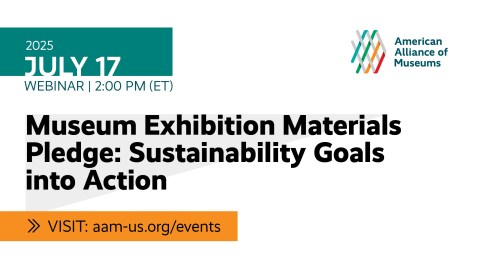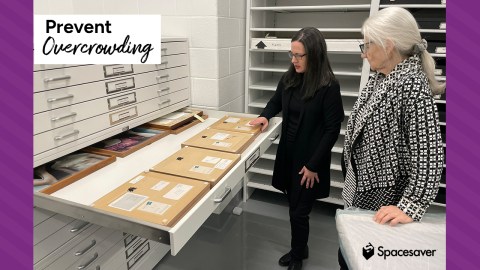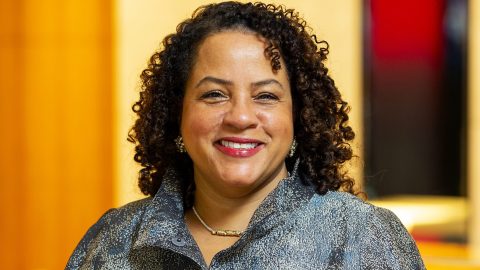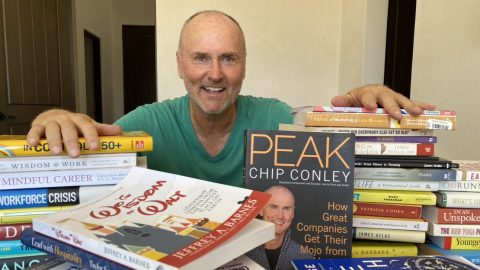
[cs_content][cs_section parallax=”false” style=”margin: 0px;padding: 0px;”][cs_row inner_container=”true” marginless_columns=”false” style=”margin: 0px auto;padding: 0px;”][cs_column fade=”false” fade_animation=”in” fade_animation_offset=”45px” fade_duration=”750″ type=”1/1″ style=”padding: 0px;”][cs_text]Noted museum bloggers Sarah Erdman, Cabinet of Curiosities, and Marieke Van Damme, Joyful Museums, join Claudia Ocello, President & CEO of Museum Partners Consulting, and Dawn Estabrooks Salerno, Deputy Director for Public Engagement and Operations at the Mystic Museum of Art in this post about why more museum professionals are leaving the field.[/cs_text][/cs_column][/cs_row][/cs_section][cs_section parallax=”false” style=”margin: 0px;padding: 0px;”][cs_row inner_container=”true” marginless_columns=”false” style=”margin: 0px auto;padding: 0px;”][cs_column fade=”false” fade_animation=”in” fade_animation_offset=”45px” fade_duration=”750″ type=”1/4″ style=”padding: 0px;”][cs_text]

[/cs_text][/cs_column][cs_column fade=”false” fade_animation=”in” fade_animation_offset=”45px” fade_duration=”750″ type=”1/4″ style=”padding: 0px;”][cs_text]

[/cs_text][/cs_column][cs_column fade=”false” fade_animation=”in” fade_animation_offset=”45px” fade_duration=”750″ type=”1/4″ style=”padding: 0px;”][cs_text]

[/cs_text][/cs_column][cs_column fade=”false” fade_animation=”in” fade_animation_offset=”45px” fade_duration=”750″ type=”1/4″ style=”padding: 0px;”][cs_text]

[/cs_text][/cs_column][/cs_row][/cs_section][cs_section parallax=”false” style=”margin: 0px;padding: 0px;”][cs_row inner_container=”true” marginless_columns=”false” style=”margin: 0px auto;padding: 0px;”][cs_column fade=”false” fade_animation=”in” fade_animation_offset=”45px” fade_duration=”750″ type=”1/1″ style=”padding: 0px;”][cs_text]We’ve all had the conversation. Maybe it was with your work buddy, or your former museum studies classmate as you caught up over drinks. Or maybe it was you, at home with your partner. The conversation often starts with, “I love working in museums, but I don’t think I can do it anymore because of [insert reason here]. I’m thinking about getting out of museums altogether.”
There’s been a lot of talk in recent years about the conditions museum workers face. (See the recent protest by Plimoth Plantation workers, Museum Workers Speak, Gender Equity in Museums Movement, Joyful Museums, the Emerging Museum Professionals group on Facebook, just to name a few. For further resources, see below.) We wanted to know: Are these difficult working conditions enough for dedicated (and highly educated) museum professionals to abandon their years of experience to start over in another working environment?
After the 2016 AAM conference in DC, a group of four museum professionals (Claudia Ocello, Dawn Salerno, Sarah Erdman, and Marieke Van Damme) got together to try to find out the reasons museum workers leave the field. We drafted a survey and shared it in the fall of 2016, asking for museum professionals both in the field and those who have left it. Over 1,000 of you responded (thank you!). Below is a summary of our findings. This was not created as a scientific, systematic survey, but rather one that “takes the pulse” of the situation. Here’s what we found.
Why we got into museum work. No surprise, whether you’ve left museums or are still working in them, you chose it as a field because you love museums and/or the content area in which you work. You also like the cross-discipline nature of museums and, to a lesser extent, the community-focus of museums.
Why we stay. Hands down, we stay because of the work we do. Unsurprisingly, for those of us who have made lifelong friends at our museums, we also stay because of our coworkers. The close 3rd and 4th reasons for staying are “Pay/Benefits” and “No Other Option.” The least popular response was “Feel Lucky to Have a Job” (1%) and the write-in “I love dinosaurs.”
Reasons why museum workers leave the field. We had about 300 answers to this open-ended question. We grouped them by theme and found the following reasons (in order of frequency of response):
- Pay was too low
- Other
- Poor work/life balance
- Insufficient benefits
- [tie] Workload/Better positions
- Schedule didn’t work
Here are some of the answers to “other”:
- Too few job openings, even in an area rich with museums.
- Was unable to advance beyond entry level despite earning an advanced degree. Left because another nonprofit offered me a higher level position.
- Had a child. Didn’t make enough for childcare.
- I felt I wasn’t effectively serving the community and couldn’t find museum opportunities where I could accomplish that.
- The work/life balance was not there (more work than life).
- No maternity leave/FMLA
- My “advanced” age seems to be a problem. I entered the field late in life, after returning to grad school.
- Racism- Too many white people hiring other white people and too many white people using the white savior approach when doing community outreach in underserved communities./em>
- Unable to secure job: overqualified and under experienced, with only very loose connections.
- I was on a project-based position and once the position ended I was not fortunate enough to find another job in the field.
- Every position I applied for, I was beaten out by Ph.D. candidates for entry-level positions.
At what point do museum workers leave the field? We wanted to know if there was an average time in a museum worker’s career when they decide that museums aren’t working for them. We found that when a former museum worker listed “pay” as the top reason they left, they were emerging museum professionals (less than 10 years in the field) although it was chosen as a primary reason in every age category by at least a third of respondents. Those who cited “work/life balance” as their reason for leaving were 16-25 years into their museum career and no other group cited this reason.
What would entice workers to stay in museums? Unsurprisingly, the overwhelming response was pay (51%). Tied for second place were advancement opportunities and support of staff, budgets, and projects (23%). Third, was a change in leadership (18%). Here are some of the open-ended responses from that question:
- Stop letting vice presidents bully their own and other staff. Show strong leadership from the executive level that brings all departments together, instead of driving wedges and saying that some staff’s work is less important than others.
- Value my perspective, promotion
- Create/collaborate on a senior level position that’s both challenging and has real impact on the organization. Also, be willing to not shortchange the position.
- Greater commitment to professional development and fostering best practices at the governance (Board) level
- Remove members of management that make the work environment hostile. Give opportunities for advancement cross-departmentally. Work on providing funding to allow employees to participate in relevant workshops and conferences in order to enhance their skills. Provide better pay especially for those of us with masters degrees. We should be compensated for that kind of experience.
How can we prevent museum workers from leaving? Again, increasing pay was at the top of the list, but respondents also suggested many free or cost-effective ways to create better working environments, like:
- Create mentoring opportunities
- Respect each other – break departmental silos
- Make room for new ideas
Thinking of leaving yourself? There was also this idea: It’s okay to leave the museum field. Leaving isn’t bad. And for those of you considering leaving museums, our survey found that most people who left are working in the private/non-profit sector, and many of them went into education. And, unsurprisingly, your museum skillset is transferable: more than 1/3 of respondents said research and writing skills, project management, and education skills they learned in museums carried over to their current jobs.
If you’ve read this far, we suspect you are either thinking about leaving museums, or are concerned about the conditions in the field and don’t want to see more of your friends, employees, or colleagues bow out. We get it. We know that working in museums is a complicated, messy tangle of good (our passion for the mission, great coworkers, opportunity to work with the public) and bad (discriminatory societal and economic systems, student loans, intense job competition). If you want/need to go, we understand, and hope our colleagues field-wide will let you go with understanding and without judgment. You can always come back!
For those of us staying, we have to be part of the solution.
Personally:
- Take care of yourself. Recognize the signs of burnout and listen to your body.
- Be realistic about the amount of work you take on, the true toll of your commute, and your work/life fit.
- Give yourself credit for the work you do and ask for help when you need it.
- Grant permission (to yourself, your coworkers) to slow down and be human.
Professionally: There is a lot that we can do as individuals to help support each other in the field
- Model reasonable professional expectations. Take your vacation days, don’t answer email on the weekends.
- Show genuine respect for others in your institution.
- Welcome new ideas and contributions from others, no matter where they are on the organizational chart. We all have something to give, and we all have something to learn.
Institutionally
- Encourage professional development opportunities, including mentorship at all levels.
- Keep all administration—including the board—mission-focused and responsible
- Look critically at benefits, pay and work/life fit to make sure it is meeting the needs of your employees.Buy the latest salary survey and bring it to a board meeting.
- Commit to diverse hiring
Of course, we wish we could say with confidence “Just make these changes and all will be well.” Sadly, we can’t. Finding ways to make real, sustainable change in our field is going to be a group effort. We need a foundation of real support to keep the museum workforce strong. That is why we need you. Keep talking and sharing your thoughts and ideas. Leave a comment on this article, get discussions going on your blogs and social media platform of choice. Talk about this on Twitter (use #MuseumEdChat or #leavingmuseums so we can find you!). Use this survey as jumping off point for more research.
Museums are often praised for their passionate and skilled workers. To keep our field strong, we need to look beyond the passion and see what really is needed to help professionals join and stay in the museum workforce.
To view all the results of the survey, we have created a Google Slide Presentation.
Resources:
Joyful Museums: Together We Can Make Work Better
The Female Gaze: It is Brave to Quit the Museum Field Part 1 and Part 2
Gender Equity in Museums Movement
Emerging Museum Professionals Network
Museum Partners Consulting LLC
Why I Left The Museum Field: A Guest Post By Claire Milldrum
Who’s Leaving the Field and Why Data Matters
About the Authors
Sarah Erdman is a mom, museum professional, and early childhood educator. Her research and professional practice explore how museums and educators can connect to make meaningful experiences for young children. She writes at cabinetofcuriositiesva.com and tweets from @cabinetofcurios
Claudia Ocello is currently President & CEO of Museum Partners Consulting, LLC, Claudia has over 25 years’ experience in exhibition development, education, evaluation, and accessibility. Previously she worked full-time at Save Ellis Island, Inc; The New Jersey Historical Society; and The Barnum Museum, CT. A former classroom teacher, Claudia earned an MS in Museum Education from Bank Street College of Education and has won awards from AASLH, AAM, and the NJ Association of Museums for excellence in exhibitions, programs, and practice. Ever grateful, she “pays it forward” by teaching in Seton Hall University’s MA in Museum Professions Program and volunteering on the board of the Education Committee of AAM. Learn more at www.museumpartnersconsulting.com and @museumptnrs.
Dawn Estabrooks Salerno is Deputy Director for Public Engagement and Operations at Mystic Museum of Art in Connecticut where she oversees operations and public programs. She has held positions in the education departments of The Wadsworth Atheneum and Lyman Allyn Art Museum where, among other initiatives, she faced the challenge of engaging local, largely minority, audiences with museum collections and exhibitions. As an educator, she has been responsible for developing, implementing and evaluating a variety of programs for a range of audiences. She has been a grant reviewer for the Institute of Museum and Library Services and for Connecticut Humanities, and she is on the board of the latter. As a New England Museum Association Board member she has served on the Advocacy, Nominating, and Program Committees and she will take office as President in November of 2017. She has contributed to the museum field by presenting conference sessions and by writing and editing articles on the topics of education, museum audiences, and the field. The Connecticut Art Education Association voted her Museum Educator of the Year in 2010. She earned her Master’s degree in Museum Education Leadership at Bank Street College and her B.A. in Classical Studies and Religion at Boston University. More recently, she completed a 2017 residency in Museum Executive Leadership at the Getty Leadership Institute.
Marieke Van Damme lives and works in Cambridge, Massachusetts, blogs at Joyful Museums, and podcasts at Museum People. Her museum areas of interest include workplace culture, equity, and making history relevant. She proudly serves a member of the New England Museum Association’s Board of Directors.[/cs_text][/cs_column][/cs_row][/cs_section][/cs_content]








Great post! Thanks for sharing.
Thank you! I’m glad you enjoyed it (Sarah Erdman)
Bravo and thank you to all four of you (and Alliance Labs) for a great piece. I would add that at the institutional level, AAM and AASLH need to work together to encourage museums and heritage organization boards to take their roles as employers seriously, offering equitable wages and benefits, an HR office or the equivalent, as well as professional development opportunities. I know many organizations respond by saying if they give raises, they can’t heat the building, but institutions on the edge financially aren’t institutions that can be agile or innovative. And attrition at the start of a career or the mid-career is a liability for all of us.
I think you phrased it well when you said that they need to take their role as employers seriously and also that professional organizations should back that up. I know sometimes people dismiss that as too “corporate” but it is essential!
Sorry! Meant to sign it as Sarah Erdman (one of the authors)
This post is closely aligned with a conversation that took place at AASLH about mid-career mentoring, and which was apparently discussed at SEMC and will be at NEMA. I’m interested but not surprised to see mentoring opportunities on the “to-do” list. Clearly we all need to be digging deeper into these issues.
I definitely feel like mentoring at all levels is important, but sometimes those “mid career” folks can get really lost in the mix. Would love to hear more about what the conversation at AASLH was like (Sarah Erdman)
Thank you for this survey work & putting the results on-line!
Now museum workers can lobby our professional museum organisations to accept, rather than more or less stridently reject, assertions that problems exist in museum workplaces. Formal research obviously is required to validate the results. I believe strongly that it is now time for museum workers to attend annual meetings & pass resolutions that instruct professional museum organisations to carry out formal research on these matters so that we can begin to identify exactly what requires actionable strategies to solve or at least begin to ameliorate the problems.
Ok, lets permit overworked & stressed out museum practitioners to leave the field to preserve their financial, physical, mental, & spiritual health, but surely the loss of experienced, enthusiastic, & dedicated workers is a significant cost to our industry. We need to reduce the financial & human costs–to say nothing of recruiting & “on-boarding” costs of a continuing stream of people leaving the field due to such unnecessary turnover.
Specific Comments:
– chose it as a field because you love museums: This puts museum workers in the category of “occupational devotees” that places us all in danger of being exploited by museum management—either deliberately or by default—depending on worker love for the job as the primary means of operating in the absence of the time, tools, & resources actually required.
– citing “work/life balance” tends to be age-related: I suggest that one reason for this may be the unabashed career advice promulgated by the American Alliance of Museums that in a 2012 Museum 91 (3): 44-9 article [reprinted from AAM’s 2012 book A Life in Museums: Managing your Museum Career] shouting at us in red font CAPs that we should “DO YOUR JOB AND THEN SOME.” See the blog post & related items at https://solvetasksaturation.wordpress.com/2013/01/14/expectation-inflation-do-your-job-and-then-some/
– What would entice staying? Third, was a change in leadership (18%): for some critical museology on museum management, see blog post & the following Comment at https://solvetasksaturation.wordpress.com/2015/05/15/managing-expectation-inflation-resulting-stress-in-museum-work/
– Grant permission (to yourself, your coworkers) to slow down and be human: workers certainly can attempt to do this, but we have little power to enact this effectively without conflicting with the constantly rising expectations of managers, institutions, museum standards, governments, & our visitors. I maintain that unrealistic & unresourced expectations are the primary driver of dissatisfaction with working conditions in our field [& most other sectors too]
– Besides the means mentioned in the Professionally section: I believe strongly that museum workers need to assert their rights as the “member-owners” of professional museum organisations. If we can begin to take control over our working lives by persuading our professional organisations that changes to pay, expectations, & working conditions are necessary, there will be no need to create a Museum Workers of the World Union.
Thank you for your thoughtful comments and task oriented ideas. We definitely hope that someone will do a more stringent and far reaching study of this topic to get more data! (Sarah Erdman)
Paul: Good points. Regarding professional organizations, perhaps the regional and specialized organizations and sections rather than AAM itself might be the venues for the most effective grass-roots efforts. But you also raise the critical point (below) that the institutional and individual members of our professional organizations may have opposing interests on this subject.
So when will AAM tie accreditation to fair pay and labor practices?
Excellent question!
EUREKA! Don not accredit institutions where a hostile environment, pay inequity and obfuscation of advancement are part of their culture!
Paul: Excellent question! Exploitation of museum workers in lack of fair pay & attention to other workplace problems such as expectations for museum workers to “overwork” above & beyond what we are actually paid for in order to achieve museum goals absent sufficient time, tools, & resources needs to be addressed by AAM & other such organisations. I suspect that many museum workers who toil longer hours than they are actually paid for are working illegally in many jurisdictions. [e.g. I have been told HR departments are not anxious to record unpaid hours as is recommended] Above and beyond the legality here, I point out that many of our institutions–even those who are accredited–fail to adhere to the AAM Code of Ethics for Museums regarding the responsibility to “protect” our human resources as well as collections (American Association of Museums 2000, 2). I do not advocate here for creating a separate Museum Workers of the World Union. However, we do need to wrestle with how professional museum organisations at all levels deal with opposing interests among its institutional & individual members. This seems to me to be a crucial question when we discuss fair pay & labour practices in museums.
Work/life balance is very important, as I found out the hard way. I’ve been in the field for 17 years and I have started saying to folks “I used to live to work; now I work to live.” I’m still busier than I’ve ever been in my career, but I make sure I balance that with hobbies outside the field.
I agree that in most places entry level pay is pretty poor. I struggled for at least the first 10 years of my career, but struggle still. After 17 years, I still have to do some adjunct teaching at a community college to feel “comfortable.” At the same time, I’m not sure what kind of job I’d be qualified for that would pay any better and being over halfway to retirement from our state system it would be hard to just give that up. Its a good thing I love my job, or I could easily feel trapped.
Andrew, your comment sums it all up so well–there are many factors in this discussion, not just pay. I’m glad you love your job! That makes all the difference.
Wow,Excellent points! And thanks for this opportunity reply from my experiences and discussions with others over the past year.
Like any profession, there are imaginary and high expectations, of Museology & Museum Studies grads/post grads. Too often this is seeded by 1. Some in academia perpetuating unrealistic ideas of museum functions, museum staffing/work, and the field of anthropology/archaeology work. 2. Society’s erroneous ideas about museums, their funding and who is actually qualified to do the job.
For many already working in the field, (qualified museum professionals either through degree and/or experience) see by decree of wealthy citizen boards, that a new ivory tower is created, or they continue to work in the shadow if one, or deal with the clueless administrations. So some general questions to think about outside of your own orbit. How many museums are closing? Who is counted as a ‘museum’ by the field? How many actually have a real consistent revenue source without donor/funder intervention? How many have seen the drastic decline in community, state or national support? How about the same organizations getting the grants or awards? How fair is it to eager students to begin having perpetual academics teach history, museum studies and archaeology only to foster the instructors need to publish? Imagine doctors teaching medicine without ever having been a practicing doctor.. it’s happening. When will it be ok for ANY person of ANY background or gender, who is qualified, to work in the field without discomfort? (as human beings, all are guilty of unconscious bias whether in the workplace or life. We all have to work at speaking to each truth, thereby educating ourselves and others. nuf)
How did I end up in collections management and as a curator over the last 15yrs? In the mid1990s-early 2000s, the art galleries started to close up, (no fulltime management/curators needed); faux finishes and painting conservation started drying up in preservation (had to close my business); exhibit design/building went out of house (no fulltime exhibit staff/preparers needed). Arts and Museums were not high on public school curriculums (there goes the school group visitor). And a few terror attacks, non-profit funding cuts, financial meltdowns, and jobs going overseas. Go figure.
All the things mentioned in the blog don’t help the field, but also think of this: The public thinks Mr. & Mrs. Title-balm do a ‘swell’ job with the museum as board members and funders. They also bring in the ‘To-Do Club’, ‘local college unpaid interns’ and ‘friends’ group to keep the place going. Yes, they do put on the exhibits, programs, etc. with help from 6 month contracted ‘museum staff’. So, Boards help create toxic environments too. We as professionals share and respect volunteers, shouldn’t they, if in power, respect us too?
All this and slowing visitation, even at the large museum level, points to nothing will change. Not so fast, putting on my glass-half-full hat… as with everything, over time, signs of hope do emerge. I think that we as professionals cannot just count on AASLH & AAM alone to advocate for us. We need to become the advocates, elected officials and board members too. So if you choose to remain or leave the field…. work your best, but as a museum pro, find a way to use those talents differently inside & outside of work. Become a board member (I did, and put limits on my time given) or fight to teach our eager students (I’m a mentor), shout out to make the public know and care that museums at ALL levels count. Regardless of what you do, make a social life away from work. That’s partly a personal thing.
It still sounds corny, but change really does start from within and in one’s own backyard. Keep this conversation going for the future of our field and museums. Finally, if you get into the field, or are already in it, try not to be one of those people you loathe.
Thanks everyone for these comments. Clearly this is an issue in the field and we’ve gotten beyond the step of realizing it’s an issue… action is required.
As someone who teaches in a Museum Studies Grad program, has been in the field awhile, and serves as a mentor, I try to be honest with my students and mentees. But that only goes so far. Paul, your comment about tying accreditation to fair labor practices, and Sarah Jencks, your note that this conversation has happened at AASLH too, indicates to me that the time is now for these two organizations to collaborate – maybe even bring in some of the other acronym-based museum organizations – to figure out next steps on a national level while we all work at the local level to make the changes we can.
One other question I would like to have asked on the survey – how many people are working more than just the museum job in order to survive? (I am, and have done so pretty much since I started in the field…)
– Claudia from Museum Partners Consulting (one of the authors)
I just left the field and this made me feel so much better! I have grappled with so many parts of this inner dialogue, “should I stay or should I go” (for several years) and finally let go. I loved the work but became very frustrated with a field that didn’t value my degrees. Seething anger would bubble up in me when I saw job postings asking for a Master’s Degree but then only paying $10hr. I was able to make a living with two part-time museum jobs but when I reached the top of both of those ladders and realized I still needed better benefits, it felt like a good place to end, at the top of something. All the best to those that can make it work and continue to do such fulfilling work!
One reason not really touched upon: what happens when a museum itself changes its focus, goals, etc., and essentially becomes less of a true museum. That was my own experience with a county natural history museum in CA: a change in focus in county administration put profitability above all other considerations. Museum staff were cut, exhibit halls were closed, research was terminated, collections work was halted, and cooperative arrangements with outside entities were closed out. Curators and collections staff were reassigned to operations – running the front desk, running the gift shop, etc. Normal personnel protocols w/ respect to job security were dimissed; anyone could be fired at any time, for any reason, irrespective of seniority or past achievements. Given that discouraging and oppressive atmosphere, I moved on to other pursuits. Nor was I alone – every other curator I worked with left as well. (It would be lovely if the AAM reviewed the institution’s accreditation in light of all this, but I doubt they will; easier just to reaccredit them and not get into messy details.) I truly miss the museum job I once had – I was a curator at an institution where I’d worked for nearly 25 years, and had been a museum professional for over a decade before that. But the curator job I once enjoyed no longer exists; so although I’m no longer working in museums, I’m still probably better off.
Thank you for this. It makes me feel like I’m not alone. It was a heartbreaking decision for me to leave the field, but I am incredibly grateful to have used my experiences and networks to continue to keep working in the field of arts and culture. I intend to advocate for equity in museums from the “outside,” as this issue is of deep personal importance. There is nothing that brought me such gratification as being a museum educator, but the deeply hierarchical, distrustful, racist, environment coupled with lack of appropriate pay or even appreciation was too hard on my emotional well being. I am pleasantly surprised to learn that not all cultural organizations operate this way, and it gives me hope that museums can change, if they are willing. It will take decisions from leadership to make this happen, and all citizens that benefit from these spaces must hold leadership accountable. I will do my part for all of us who left, and all who remain.
Madalena–
You might want to consider joining the work of Gender Equity in Museums (GEMM) https://www.genderequitymuseums.com/. You can also find us on Facebook. GEMM is open to everyone with an interest in workplace equity–especially museum workplace equity.
Regards,
Joan Baldwin
leadershipmatters1213.wordpress.com
Thank you for such an interesting discussion! Many of these issues are reflected in the situation of museum workers in Australia. Our large, national and state government institutions have been subject to progressive funding cuts (“efficiency dividends”) over the last decade, while community and volunteer museums in my state – New South Wales – have recently been described as a ‘cultural ghetto of poverty and entrenched disadvantage’ by nationally respected museum and heritage consultant Kylie Winkworth. There has been some allocation of new funding through recent cultural policy frameworks at national and state level, but most of this money goes toward building new infrastructure without supporting ongoing operational costs (salaries, program development, etc.). There is a lot of frustration, and insecurity, in the museum profession as a result, and I think it’s damaging our ability to interpret collections.
Why is it that the four women who conducted this study and wrote this blog post are all white and of similar gender? (I’m realizing I’m making an assumption based on photographs.)
Too many museum people work more hours than they should for many reasons: fear of being replaced if they don’t get the work done, allow their passions to get the better of them, pressure from peers or management, etc. Doing so can be detrimental to the individual personally. I feel fortunate that my museum is city operated and my employees are in a union. That being said, I still have to kick them out the door to leave or insisdt they put d own the hours that they actually work. When it comes to that burnout point and cry for more staff, I tell them my argument doesn’t have a leg to stand on if the powers that be see that the place is functiooning and everyone has down 40 hours for the work week. So that workaholic culture can c one back to hurt you. I learned the importance of work/life balance the hard way; I try to instill that into staff (and interns as part of how I mentor) as I that they will still feel good and happy about their work years from now.
Harry, appreciate that you are instilling some work-life balance into your staff and interns. Am wondering if you notice a difference in them since doing that? It would be interesting to know if there are “before” and “after” benefits for the museum as well as for their own lives.
– Claudia (one of the authors)
Has anyone gone back to pre 2000 when a lot of history and public history departments were scrambling to put together undergrad museum studies courses as a way for their grads to find employment? I recall discussions at the time that observed that there were not enough professional level jobs in the field to employ all of the newly trained grads who might seek employment in that sector. There continue to be discussions, too, about the value of undergrad classes, certificate programs and more rigorous master’s degree programs with rich hands-on curricula. Have we given students the false impression that they are ready for professional positions with a few undergrad classes, or with solely on-line or reading-only curricula?
Harry: I agree!
Those museum ‘occupational devotees’ who need direction in how to reduce their overwork should read Ury, William (2007) The Power of a Positive No: How to Say No and Still Get to Yes, New York: Bantam Dell. Ury, Director of the Global Negotiation Project at Harvard, presents a workable plan of action for basing a ‘No’ on first saying a positive ‘Yes’ to the worker’s own values and core interests (Ury 2007: 2, 17-18, 34, 43, 80-1, passim). The Ury process then presents strategies for how to say No to unrealistic demands and how to propose potential compromise alternatives leading to an eventual Yes through negotiation.
The second best book for help is Posen, David (2013) Is Work Killing You? A Doctor’s Prescription for Treating Workplace Stress. Toronto: House of Anansi Press Inc.
More help for museum workers currently burning themselves out to a crisp is available at Solving Task Saturation for Museum workers at https://solvetasksaturation.wordpress.com/ . This blog is focussed on analysis of & presenting solutions to the problem.
I am leaving museums after approximately nine years in the field. I’ve found myself growing resentful of museum management and executives who demand years-long experience and graduate level degrees without offering any kind of institutional support (flexible working hours for academic programs, living wages to offset loans and debt). I simply can’t convince myself that a masters degree is a safe investment (folks with PhDs applied for my last position while I have only a BA), however, it’s become very clear that I shouldn’t expect any upward mobility without one, regardless of experience. (I should mention that I’m leaving my current position in part because management would not allow me the flexibility to pursue a masters part time.)
Bingo. I’m also looking to leave after 9 years. No room for advancement despite my experience/expertise/qualifications, I earn less than a first-year teacher who only has a bachelor’s degree (oh, the amount of times I’ve had to ask my parents for help because wages here don’t support the cost of living), and yet, on top of all that, I’m expected to put in 50 or more hours of work a week without earning overtime pay because I’m salaried. I’m the only person in my department, but goals for revenue and attendance numbers are unrealistic for one person to achieve.
I’d also like to add that museums need to stop expecting staff to crank out a high volume of programs without hiring additional staff. That’s where the work/life balance gets out of whack. I’m seeing such burnout and high turnover at my current job because it’s not a sustainable model. Revenue goals need to be reasonable, and pressure to bring in revenue needs to let up.
And for crying out loud, find money to assist with relocation for new employees, or don’t hire people from long-distances.
Also, stop hiring people for executive director positions who have never worked in museums before. Stop hiring unqualified people for upper management, period. It sucks to work under someone who doesn’t understand your job, can’t contribute to your work in any meaningful way, and yet gets to tell you what to do.
Yes, I’m very resentful of this field right now.
Sadly, that all sounds terribly familiar. It’s awful when a museum person finds themselves at a point when they have to leave the museum world; but sometimes it’s necessary for one’s health and happiness.
Interesting discussions and comments. I have been fortunate to want and have a life in museums. I always considered it a calling not a career. As I tell my graduate students on the first day of class, if you think of museum work as a job, please leave. My class is about the ideal and the real (as is my new textbook) and they rarely meld in our line of work. The ideal is what we shoot for, the real is where we land. The whole notion of a museum is preposterous. Who on earth thought of establishing places that hold opbjects forever for some lofty reason that can change at a moment’s noptice, or without notice. Why do they really exist? They are very expensive to operate optimally, which is why they rarely operate in a totally optimum manner. Fortunately the public, however you want to define that word, knows what museums are for and why. They are, ultimately, my final judge of success, not boards of trustees, staff, volunteers, colleagues, critics, consultants, etc. Anyone contemplating a life in museums must know what the pitfalls are, but, they are no different than those encountered in other fields. I have been fortunate in my work-life but when problems have erupted and I felt I could no long practice my craft to the best of my ability, i moved on. Good Luck to All.
steve
Steve: I agree it’s crucial to know that people entering the field understand what the pitfalls are in museums, and that our ideal is likely quite different from reality. However, I think that talking about our work as a “calling” is problematic. Yes, we may be passionate, dedicated, and completely committed to what we do, but museum work IS a job. The idea that passion offsets the negatives only provides an excuse for the field to not have to address its serious employment issues. There are lots of other fields where staff are passionate AND fairly compensated, with job security, benefits, and a clear understanding of how to move up in their field (librarians, teachers, firefighters, surgeons, and on and on). Why not us?
Dear Claudia and Team
I also left the field. I enjoyed your article and need a bit more time to read it more thoroughly I think. My main reason for leaving was caring for elderly relatives who live in a remote part where there are few museums and museum jobs are scare. The expertise I have I can put into freelancing as I have discovered my heritage and arts project management skills, knowledge and experience are sought after especially here in a rural area of low population. The fact there are some parts of the country that are so poorly served with with museums is problematic I think in terms of raising the general quality of life for the public here and encouraging tourism. I have come home to try to assist in changing that in whatever ways are possible. The ongoing cuts to the arts here is clearly a massive issue for museums and their staff.
And I thought these problems were particular to working in museums in the UK. I worked in a small local government run museum in London for 17 years. I did practically everything, from curatorial, community projects, exhibitions to designing flyers. I think my experience is pretty solid but its never enough for a larger museum where roles are specific to one thing. For instance, I managed and trained volunteers, students and temporary staff in cataloguing, documentation and packing projects. However I didn’t have an official line management position or the word ‘manager’ in my job title so I am unable to apply for this type of role in another institution. I am now over 50, and as painful as it is, after 2 years of applications and interviews, I have to admit that this is a problem for employers. I’m sure if they were asked about it they would come up with a whole host of reasons why I wasn’t the right candidate, rather than admit to ageism, but isn’t that how discrimination works? I am now caught in an eddy of low paid, entry level, temporary jobs, with the prospect of never being able to haul my way out to use my knowledge, experience and skills.
I received a masters in museum education, and worked at multiple institutions in part time or per-diem educator jobs for five years. I had great reviews from my supervisors and peers. I was constantly applying for full time positions, and would sometimes make it to the final round, but never got the job. I ended up leaving the museum field for a full time job in Programs at a nonprofit, and now have a decent salary with benefits.
The Museum education field in particular needs to find better was to take care of and keep employees. People need a decent and steady income, they need insurance and paid time off, and they need consistency in their work. I had to work 5 different jobs at once last year, and it made me spread myself and my skills way too thin.
Further to your encouragement to comment on what can be done about the incredibly wasteful ‘problem of ‘divorce’ from a job you love, I have blogged about this important blog post and other related commentaries with documented details on possible avenues open to driving solutions at https://solvetasksaturation.wordpress.com/2017/11/14/museum-workers-leaving-the-field-survey-results-solutions/ . Let’s all help get organised to begin pressing ‘powers that be’ to accept that this is a problem requiring concerted remedial action & also support each other in escaping our own personal challenges at work..
These days, all I hear/read about these issues is silence. I suggest individuals who remain concerned & who plan to attend upcoming national and/or regional museum association annual general meetings consider introducing resolutions requesting action like the following:
DRAFT Resolution for Professional Museum Organisation Annual General Meetings:
WHEREAS: museum institutions have an ethical duty to “protect” employees [and volunteers too] on the same level of importance as collections (International Council of Museums 2004: 1; American Association of Museums 2000: 2),
WHEREAS: retention of emerging and mid-career museum professionals in this field anecdotally is problematic due to unsustainably low pay levels compounded by unreasonable expectations to overwork (Milldrum 2017; Merritt 2015),
AND WHEREAS: an informal survey of 1,067 museum workers has found evidence that, of those respondents who no longer work in the field, 65% reported low pay and 33% reported poor work/life balance among multiple reasons for leaving their museum jobs (Ocello et al. 2017: 6; Erdman et al. 2017),
THEREFORE, BE IT RESOLVED THAT:
This annual general meeting of [INSERT NAME OF ORGANISATION HERE] direct the Executive to investigate, partner with like regional, national, and international professional museum organisations to plan and carry out formal research on museum workers at all levels and, based on the results of such research, then plan and take best effort actions to address any substantive pay (e.g. Nonprofit Quarterly 2014) and quality of working life issues identified by the research to ensure that the problems identified are addressed effectively at the earliest possible dates.
References Cited:
American Association of Museums. 2000. Code of Ethics for Museums. Washington: American Association of Museums.
Erdman, Sarah et al. 2017. “Leaving the Museum Field.” Alliance Labs blog [American Alliance of Museums] posted 22 September http://labs.aam-us.org/blog/leaving-the-museum-field/ .
International Council of Museums. 2004. ICOM Code of Ethics for Museums. Paris: International Council of Museums.
Merritt, Elizabeth. 2015. “Unsafe Ideas: Building Museum Worker Solidarity for Social Justice.” Center for the Future of Museums Blog posted 2 June at http://futureofmuseums.blogspot.ca/2015/06/unsafe-ideas-building-museum-worker.html .
Milldrum, Claire. 2017. “Why I Left The Museum Field: A Guest Post By Claire Milldrum.” ExhibiTricks: A Museum/Exhibit/Design Blog posted 11 September http://blog.orselli.net/2017/09/why-i-left-museum-field-guest-post-by.html .
Nonprofit Quarterly. 2014. [Pay deficits in the case of women in museum work for example are well-documented. Nonprofit Quarterly March 2014 reporting on National Center for Arts Research found that women leading art museums “earn 79 [to 71 for small museums] cents on the dollar paid to male peers,” The GuideStar 2013 Nonprofit Compensation Report finds similar differential between pay for men compared to women across all categories. 2012 American Association of Museums study reports women make 78%.]
Ocello, Claudia et al. 2017. “Why are Great Museum Workers Leaving the Field? Survey by Claudia Ocello, Dawn Salerno, Sarah Erdman, & Marieke Van Damme.” https://docs.google.com/presentation/d/1_aHdxmG0Jdb4deqsjyhH9eoDUIPXz_EdkU-7gWuXDwE/edit?usp=sharing .
hi thanks for the information
Great Post, I really appreciate to blogger for this useful information. Keep sharing.
That’s why its always better being a visitor & enjoying all the perks!